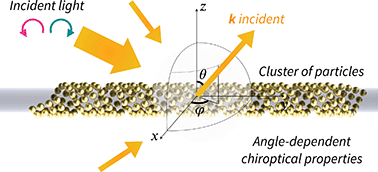Orientation dependence of optical activity in light scattering by nanoparticle clusters†
Abstract
The optical properties of nanoparticle clusters vary with the spatial arrangement of the constituent particles, but also the overall orientation of the cluster with respect to the incident light. This is particularly important in the context of nanoscale chirality and associated chiroptical responses, such as circular dichroism or differential scattering of circularly polarised light in the far-field, or local degree of optical chirality in the near-field. We explore the angular dependence of such quantities for a few archetypal geometries: a dimer of gold nanorods, a helix of gold nanospheres, and a linear chain of silicon particles. The examples serve to illustrate the possible variation of chiroptical responses with the direction of light incidence, but also, consequently, the importance of a robust orientation-averaging procedure when modelling general clusters of particles in random orientation. Our results are obtained with the rigorous superposition T-matrix method, which provides exact analytical formulas for fixed and orientation-averaged properties.

- This article is part of the themed collection: Chiral Inorganic Nanomaterials


 Please wait while we load your content...
Please wait while we load your content...